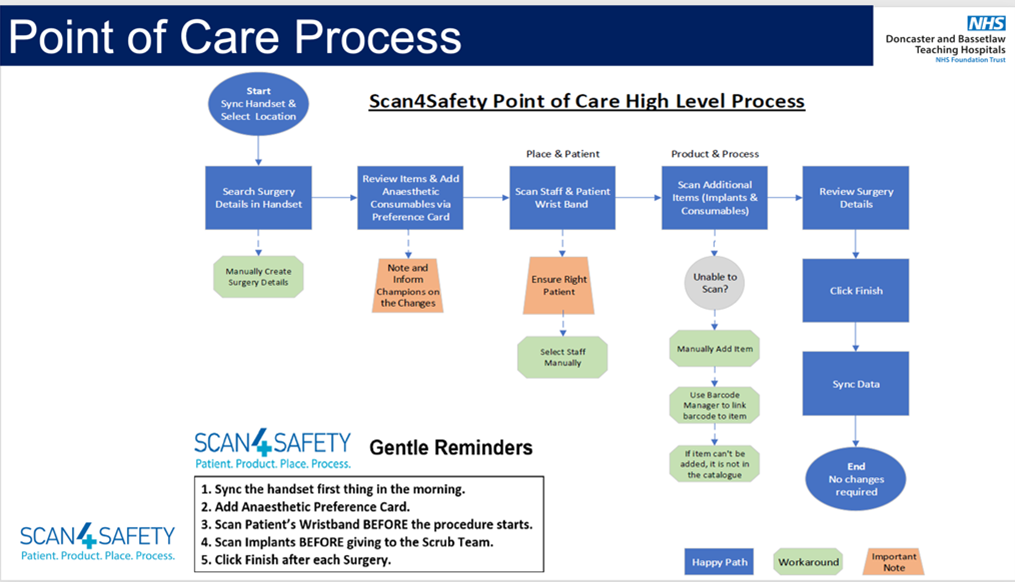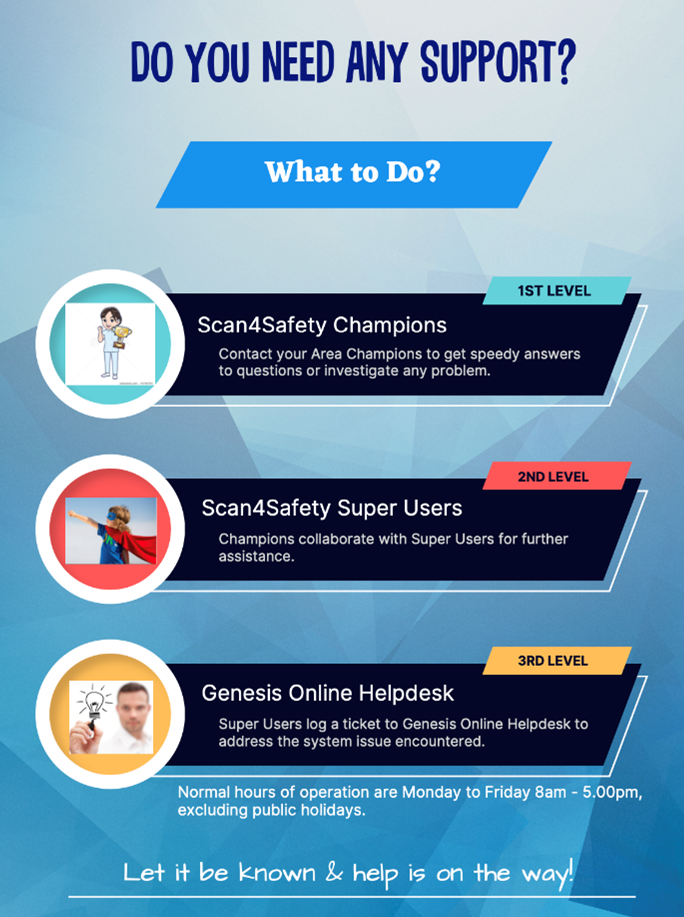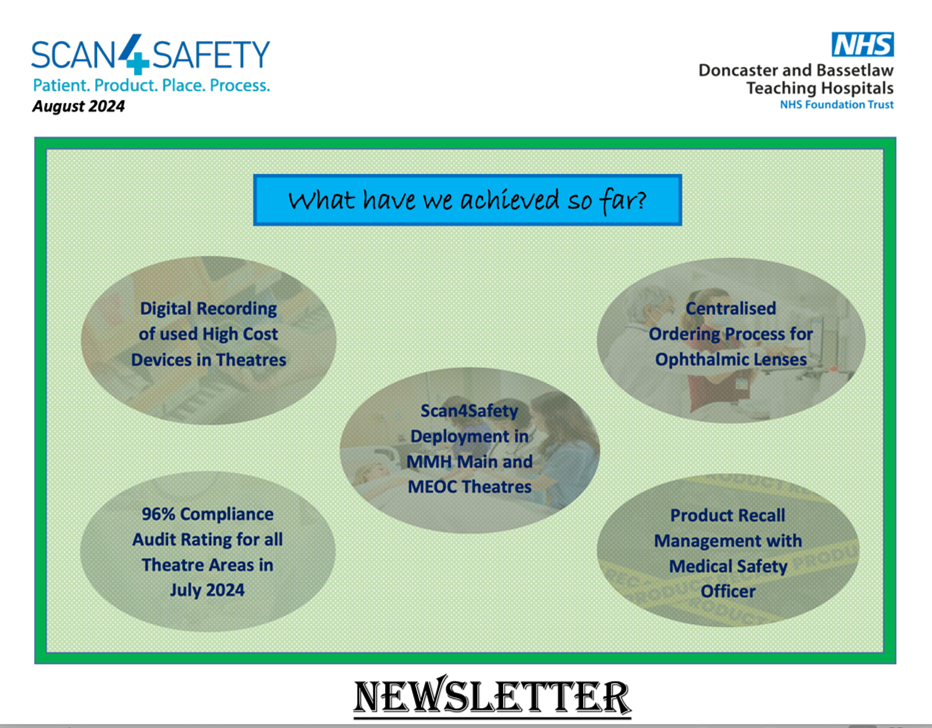How clinical engagement and change management enabled Scan4Safety benefits in theatres at Doncaster and Bassetlaw

There are multiple ways Scan4Safety is being introduced in NHS organisations, depending on existing infrastructure, resources and digital capabilities. When introducing Scan4Safety into clinical areas engagement with staff is vital.
This article explores how Doncaster and Bassetlaw Teaching Hospitals NHS Foundation Trust approached engagement to make Scan4Safety business as usual across the trust’s 28 operating theatres. You can also access examples of the Scan4Safety resources, training materials and guidance developed by the trust via a link at the end of the article.
Implementing Scan4Safety across the trust’s theatres
The starting point for Scan4Safety at Doncaster and Bassetlaw Teaching Hospitals NHS Foundation Trust was to expand the capabilities of the existing inventory management system (IMS), which had already introduced the required barcode scanning infrastructure. The trust’s initial Scan4Safety goal was to realise the additional patient safety benefits that technology could bring when used at the point of care in operating theatres.
Scan4Safety is now utilised across the trust’s 28 theatres, where barcode scanning is enabling the instantaneous cross-checking of implants, verification of expiry dates, and monitoring of any relevant field safety notices. It also ensures that accurate records of medical products used in a procedure are captured in the patient’s Electronic Patient Record (EPR).
This has introduced a more robust tracking and verification process, capturing data about medical devices and supplies used, and matching them to the patient, improving both efficiency and patient safety.
Addressing barriers to adoption
To support implementation, the trust created a role for a dedicated Scan4Safety implementation lead, bringing in Ricky Tenchavez, a nurse by background with a blend of clinical, digital technology and project management experience from working in the NHS and also in the Philippines.
Initially, the main challenge was that clinical staff viewed the IMS and the scanning of barcodes as merely an inventory tool, without recognising its critical role in patient safety. Ricky’s mission was to create a culture within theatres that recognised Scan4Safety as an important tool to enhance patient safety in everyday practice.
By building engagement and rapport with clinicians he aimed to position the scanning of barcodes as an essential practice for safer patient care.
Engaging clinicians for successful implementation
Through Ricky’s engagement strategies he emphasised the importance of hands-on training and transparent communication, helping staff appreciate the safety benefits of Scan4Safety.
Ricky developed a series of educational materials and guidelines, which were crucial in driving engagement.
He conducted comprehensive training sessions, which covered everything from scanning patient wristbands to ensuring that all implants were scanned before use. This not only improved accuracy and traceability but also helped further prevent critical errors, such as using expired items or incorrect body-side implants.
Notably, his “Gentle Reminders” cards were distributed to theatre teams, emphasising critical steps in the scanning process to minimise errors and enhance Scan4Safety compliance. This initiative streamlined workflows and reinforced best practices during high-pressure situations in theatres.
To reinforce best practices, Ricky introduced a “Scan4Safety Tip of the Week” email, offering brief reminders and practical advice on barcode scanning. For example, one tip encouraged staff to scan patient wristbands before surgery, to support accurate patient ID verification to enhance safety. These reminders help integrate Scan4Safety into daily routines and maintain compliance.
Below is an example slide from the training, showing the simple but effective approach Ricky used to educate the team:

Building a support network: Champions and Super Users
Recognising the importance of ongoing support, Ricky developed a tiered support pathway featuring Scan4Safety Champions and Super Users. These individuals acted as local experts who could provide immediate assistance to their colleagues, ensuring that any issues were quickly resolved. This empowered staff to seek immediate assistance, creating a culture of teamwork and mutual support.
The support pathway was structured as follows:
- Scan4Safety Champions: Serve as the first point of contact for basic queries and troubleshooting. Most often champions were staff with existing roles in a theatre such as a theatre nurse.
- Super Users: Provide in-depth support for complex issues. At Doncaster and Bassetlaw, Ricky was the super user.
- Inventory management system (IMS) software provider online helpdesk: Address escalated concerns requiring technical intervention. For more complex enquiries that couldn’t be addressed locally, the trust could turn to the software supplier for help.
Below is an excerpt from the support pathway diagram:

To further drive engagement and sustain momentum, Ricky also created Scan4Safety Newsletters celebrating achievements and recognising staff contributions. These newsletters keep clinical teams informed and motivated, highlighting key achievements.
For example, the August 2024 edition celebrated that a 96% compliance audit rating was achieved for all theatre areas the previous month. Articles like this helped foster a sense of collective accomplishment among clinical teams.
Below is an image of the August 2024 newsletter headlines:

Creating lasting impact
The introduction of Scan4Safety in theatres has not only improved operational efficiency, it has also ensured compliance with GS1 standards. These standards encompass unique identifiers that can be accessed, recorded and tracked via a barcode, such as a GTIN (for products), GSRN (for people), and GLN (for locations).
The impact of these efforts include:
- Reduced waste through better inventory management.
- Enhanced patient safety by preventing serious patient safety incidents, such as incorrect implants or the use of expired products.
- Increased clinical productivity through streamlining the process of tracking and tracing medical supplies.
Explore Scan4Safety resources shared by Doncaster and Bassetlaw Teaching Hospitals NHS Foundation Trust
With kind permission from Doncaster and Bassetlaw Teaching Hospitals NHS Foundation Trust, we have shared examples of the trust’s Scan4Safety guidelines and training materials on our Scan4Safety FutureNHS page (log in required). These resources provide detailed insights into the methodologies employed at the trust, along with practical templates and guides other trusts can consider adapting.
By sharing these experiences and resources, we hope to encourage other NHS organisations to adopt and adapt similar strategies, ultimately driving better care and improved patient safety across the health system.
Ricky Tenchavez is the implementation lead for Scan4Safety at Doncaster and Bassetlaw Teaching Hospitals NHS Foundation Trust. Originally from the Philippines, he has been a registered nurse in the UK since 2021. With a background as a team lead – business systems analyst, Ricky combined his expertise in project management and systems analysis with his clinical experience to drive the effective deployment of Scan4Safety across all 28 theatres in the trust.
